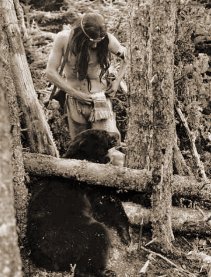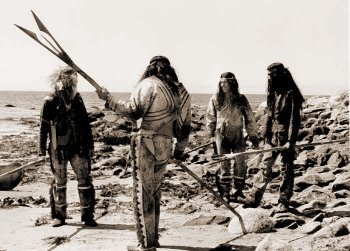 |
||||||
|
||||||
MI'KMAW DAILY LIFE |
||||||
|
Hunting
Moose was a valuable staple in the Mi'kmaw diet. Hunters were generally excellent trackers, and could determine the sex and approximate age of their quarry based on tracks and dung. They would position themselves for attacks downwind of the moose, and would often call the moose closer by imitating their own calls. Deadfall traps and head snares were also occasionally used. Using snowshoes in the winter gave the hunters a distinct advantage, as the moose generally stuck to circular paths called ‘yards’, where they were easy prey to the hunters’ spears. Smaller mammals such as muskrats, otter, mink, marten, fisher and lynx, were often taken using deadfall traps and snares. Beavers were frequently taken by damaging the dam around their pond, and picking off the beaver as they were exposed by the falling water level. Beaver were also fairly easy game in the winter, when they could be caught at their breathing holes in the ice. Ruffed grouse are easily detected because at mating time the male thumps its breast with its wings, causing a loud drumming sound. Hunters would use a leather noose attached to a pole to snare the bird at close range. Geese and ducks were often hunted at night, while they slept on the water. The hunters would allow their canoes to drift into the flock, then light birchbark torches. The startled fowl would take flight, circling the canoes in confusion, and the hunters would simply knock them down with sticks, or wait until the birds were exhausted and catch them by hand. Fishing
The Mi’kmaq relied heavily upon the sea and its products, for it supplied about 90% of his available food. Hunting for game required more skill than fishing (fish were extremely plentiful) and Mi'kmaw man prided himself on being a good provider for his family and the village. Early in the year, the Mi’kmaq lived on shallow-water fish, such as the flounder, which lives on mudflats in the low-tide zone and in the mouths of rivers and estuaries where it can be speared, caught on hooked lines or trapped in weirs. In the middle of March, fish would begin to spawn, often so abundantly that everything swarmed with them. First smelt, then herring, then sturgeon and salmon would make their spawning runs, so that the people were assured of food from March through until September, when the Mi'kmaq's favourite fish, the eel, would begin to run.
The Mi'kmaq would construct fish weirs to trap the spawning fish in great numbers. The weirs were simply V-shaped lines of obstacles (wood, rocks, etc) that were constructed across the streams, which forced the fish to pass through a narrow opening, where a basket or net was used to capture them. For large fish like the sturgeon and the salmon, the Mi'kmaq used a spear. At night, birchbark torches were used to attract sturgeon. Being a curious fish, it would circle around the canoe and when harpooned would swim
furiously, dragging the canoe until it became exhausted. |
||||||
|



